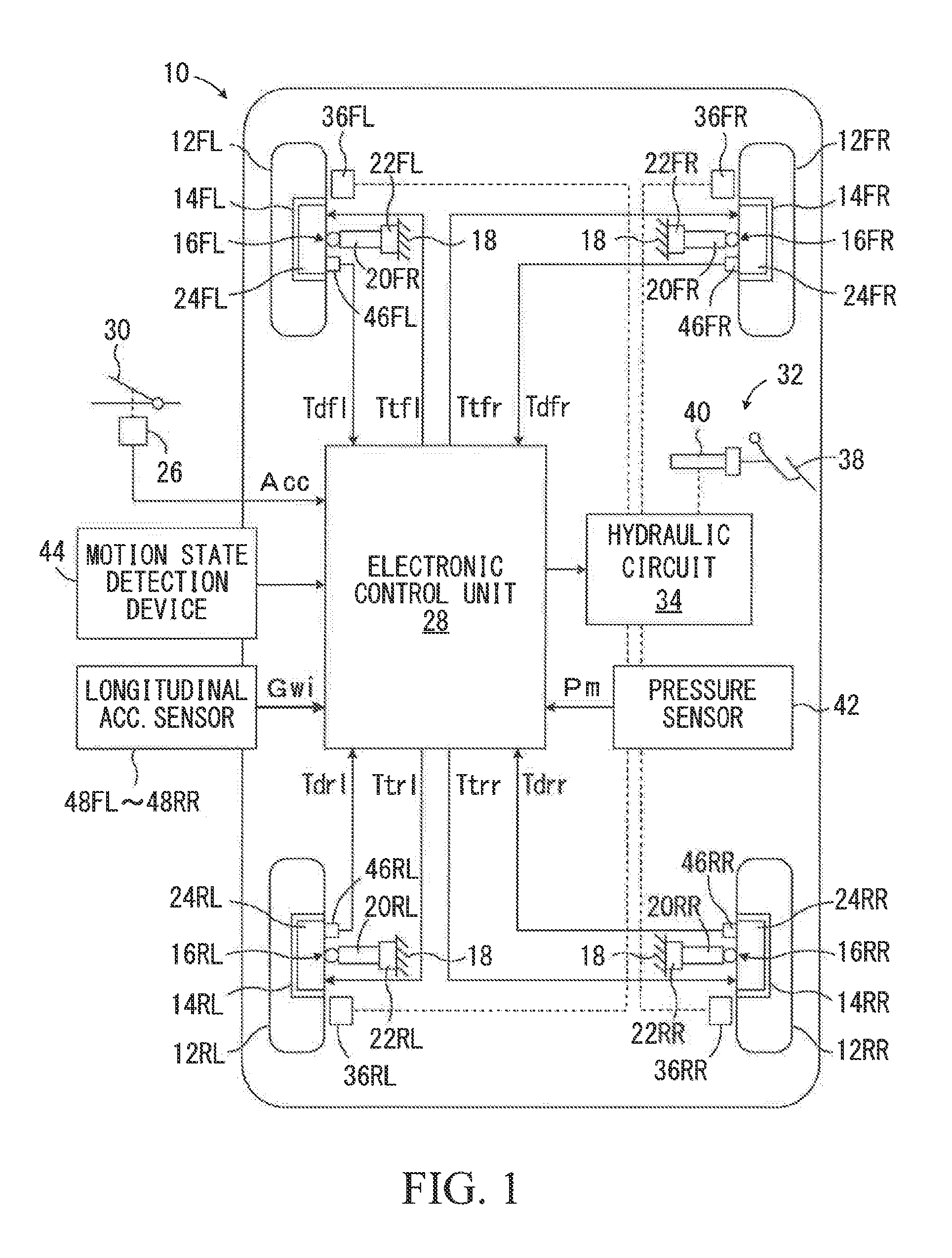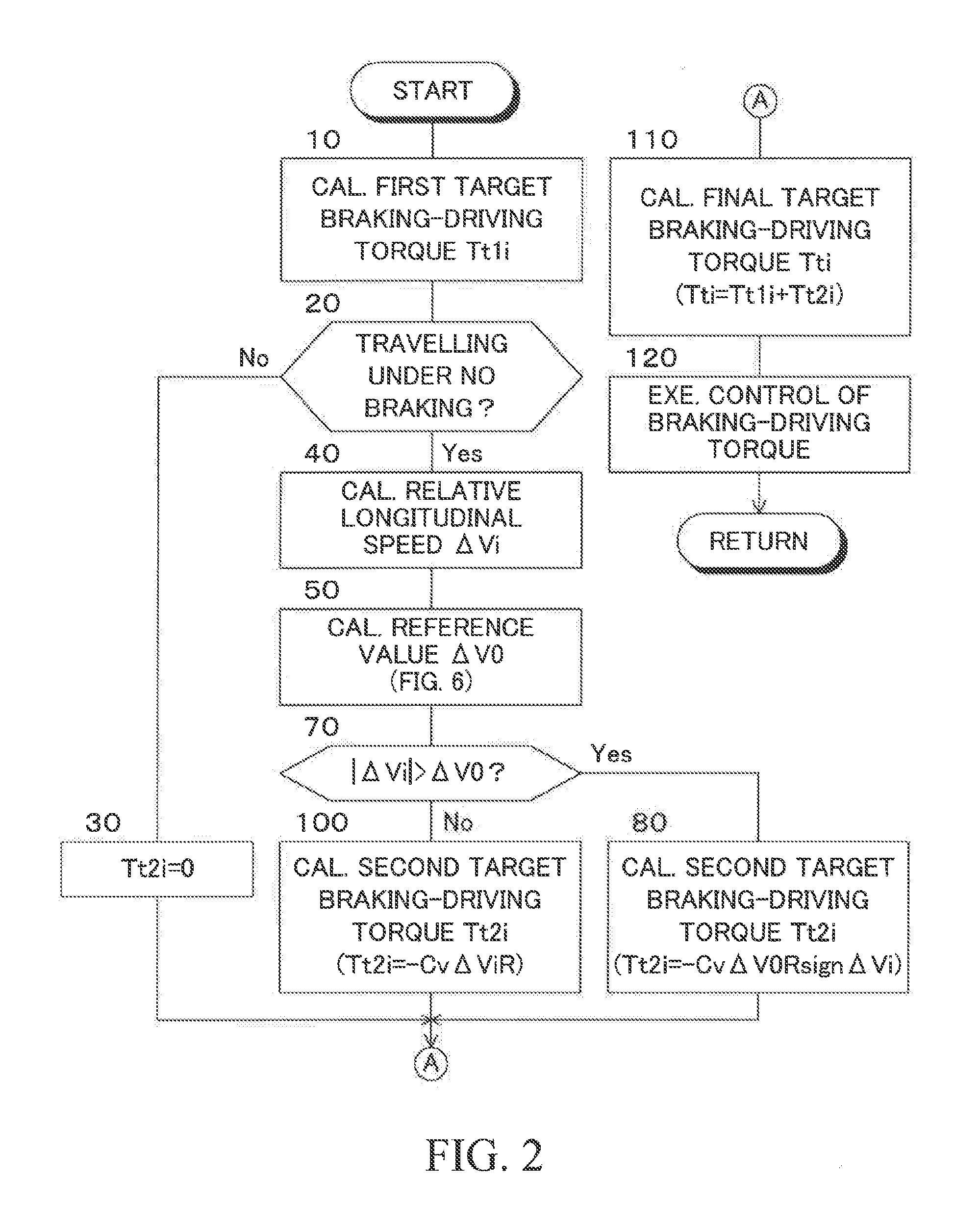Electric vehicle
a technology of electric vehicles and electric motors, applied in the direction of electric devices, propulsion by batteries/cells, brake systems, etc., can solve the problems of hindering the driver's acceleration and deceleration demand, occupants in the vehicle feel uneasy,
- Summary
- Abstract
- Description
- Claims
- Application Information
AI Technical Summary
Benefits of technology
Problems solved by technology
Method used
Image
Examples
first embodiment
[0053]FIG. 1 is a schematic view for illustrating an electric vehicle 10 according to a first embodiment of the present disclosure applied to a four-wheel drive vehicle of in-wheel motor type. The electric vehicle 10 has left and right front wheels 12FL and 12FR which are steered wheels and left and right rear wheels 12RL and 12RR which are non-steered wheels. The front wheels 12FL and 12FR are supported by wheel support members 14FL and 14FR, respectively, so as to rotate about rotation axes of the wheels. In a similar manner, the rear wheels 12RL and 12RR are supported by wheel support members 14RL and 14RR, respectively, so as to rotate about rotation axes of the wheels. The front wheels 12FL and 12FR are suspended from a vehicle body 18 by front wheel suspensions 16FL and 16FR and the rear wheels 12RL and 12RR are suspended from the vehicle body 18 by rear wheel suspensions 16RL and 16RR.
[0054]The front wheel suspensions 16FL and 16FR include suspension aims 20FL and 20FR, respe...
second embodiment
[0085]FIG. 3 is a flowchart for illustrating a routine for controlling braking-driving forces of wheels in an electric vehicle 10 according to the second embodiment which is applied to a four-wheel drive vehicle of in-wheel motor type. Note that, in FIG. 3, the same steps as those illustrated in FIG. 2 are denoted by the same step numerals as those of FIG. 2. The same goes for FIG. 4, referred to later.
[0086]As is understood from comparing FIG. 3 with FIG. 2, in the second embodiment, when a negative decision is made in step 70, step 90 is conducted. After step 90 is completed, the control proceeds to step 100. The steps other than these steps are conducted in the same manner as in the first embodiment.
[0087]In step 90, longitudinal speeds ΔVi of the wheels relative to the vehicle body 18 calculated in step 40 are processed by a low-pass filter to calculate low-pass filtered relative longitudinal speeds ΔVlpi (i=fl, fr, rl and rr.) Note that a cut-off frequency of the low-pass filte...
third embodiment
[0091]FIG. 4 is a flowchart for illustrating a routine for controlling braking-driving forces of wheels in an electric vehicle 10 according to the third embodiment which is applied to a four-wheel drive vehicle of in-wheel motor type.
[0092]As is understood from comparing FIG. 4 with FIG. 2, in the third embodiment, after step 50 is completed, the control proceeds to step 60 and after step 60 is completed, the control proceeds to step 70. The steps other than step 60 are conducted in the same manner as in the first embodiment.
[0093]In step 60, longitudinal speeds ΔVi of the wheels relative to the vehicle body 18 calculated in step 40 are frequency analyzed to derive principal frequencies fm of longitudinal speeds ΔVi. Further, coefficient Cv is calculated by referring to a map shown in FIG. 7 based on each of principal frequencies fm. As shown in FIG. 7, coefficient Cv is calculated to be a positive value Cvmax when principal frequencies fm are values within a specific frequency rang...
PUM
 Login to View More
Login to View More Abstract
Description
Claims
Application Information
 Login to View More
Login to View More - R&D
- Intellectual Property
- Life Sciences
- Materials
- Tech Scout
- Unparalleled Data Quality
- Higher Quality Content
- 60% Fewer Hallucinations
Browse by: Latest US Patents, China's latest patents, Technical Efficacy Thesaurus, Application Domain, Technology Topic, Popular Technical Reports.
© 2025 PatSnap. All rights reserved.Legal|Privacy policy|Modern Slavery Act Transparency Statement|Sitemap|About US| Contact US: help@patsnap.com



